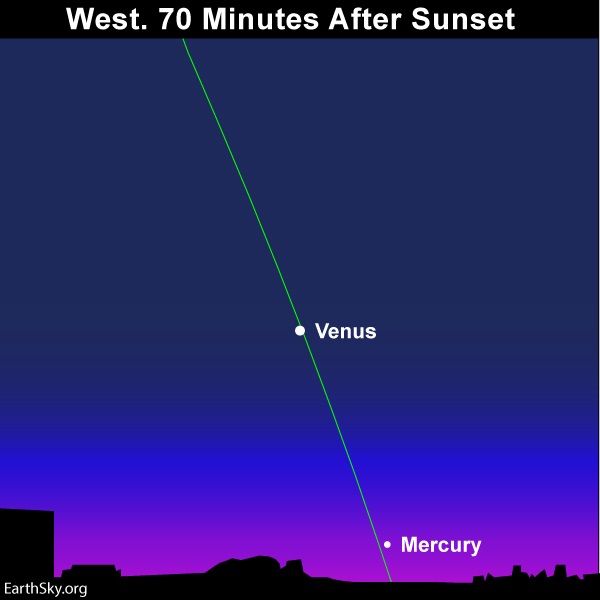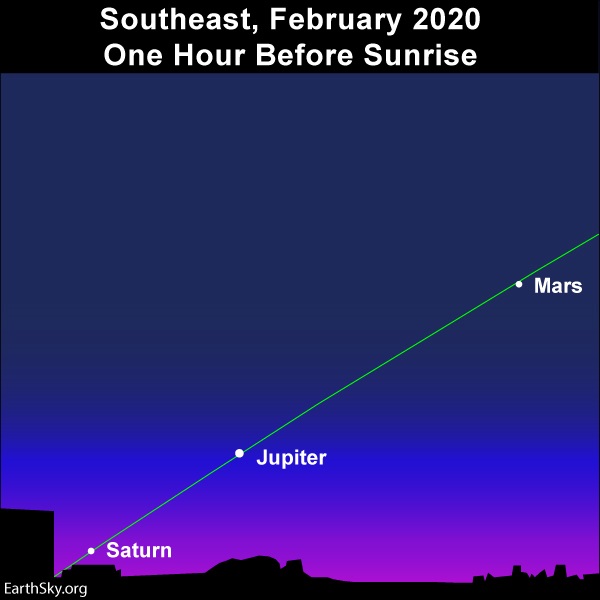
In February 2020, you should be able to see all five bright planets, two after sunset and three before sunrise. In their order outward from the sun, the five bright planets are Mercury, Venus, Mars, Jupiter and Saturn. And they really are bright and noticeable in Earth’s sky! The illustration above – which is from NASA – shows the five bright planets, plus Earth, in their order outward from the sun. Their relative sizes are correct in this illustration, but – in real outer space – their relative distances from one another are much more vast.
Spot the two evening planets – Venus and Mercury – in the west not long after the sun goes down. Then see the three morning planets – Mars, Jupiter and Saturn – in the east before daybreak.
First, the evening planets…

By bright planet, we mean any solar system planet that’s easily visible without optical aid and that’s been watched since time immemorial. There are 5 of them: Mercury, Venus, Mars, Jupiter, Saturn. Two planets are in the west after sunset now. Venus is a very bright object – brightest thing up there – in the western twilight sky. Mercury is fainter and below Venus. Don’t wait too long to view Mercury! It’ll quickly follow the sun below the western horizon.
You’ll easily spot dazzling Venus, the sky’s brightest planet, popping out some 30 to 45 minutes (or sooner) after sunset. If you’re blessed with good eyesight, you might actually see Venus as soon as the sun sets. Some people even see it in daytime! Venus beams as the 3rd-brightest celestial object to light up the sky, after the sun and moon.
Once you spot Venus, watch for Mercury to appear beneath Venus and close to the horizon as dusk deepens into darkness. IF you have binoculars, you can catch Mercury (or Venus) even sooner after sundown.
Now is the best time to catch Mercury after sunset. Mercury reaches its greatest elongation from the setting sun on February 10, 2020. At present, it shines more brilliantly than a 1st-magnitude star (but, remember, super-brilliant Venus outshines Mercury by some 30 times). AFter greatest elongation on the 10th, swift-moving Mercury will begin falling sunward. It’ll also begin dimming, from our earthly perspective. The innermost planet will become lost in the sun’s glare after about mid-February.
Mercury will be easier to see from the Northern Hemisphere than in the Southern Hemisphere. That’s because the tilt of the ecliptic – pathway of the sun, moon and planets – hits the sunset horizon at a steep angle in the Northern Hemisphere and a relatively shallow angle in the Southern Hemisphere.
We give you the approximate setting time for Mercury at various latitudes:
60 degrees north latitude
Mercury sets 2 hours after sunset40 degrees north latitude
Mercury sets 1 3/5 hours after sunsetEquator (0 degrees latitude)
Mercury sets 1 hour after sunset35 degrees south latitude
Mercury sets 3/4 hour after sunset
Want more specific information? Find out when the planets set in your sky at TimeandDate
Now for the morning planets…

To see the remaining 3 planets, you’ll have to get up early. Look east! A string of planets – Mars, Jupiter and Saturn – beautifies the February morning sky. Jupiter is much brighter than Mars or Saturn; you’ll surely spot it first. Mars may be noticeable for its reddish color. And Saturn is near the sunrise. Notice that a line between Mars and Jupiter points to Saturn.
During the predawn/dawn hours at this time of year, the tilt of the ecliptic favors the Southern Hemisphere for watching the morning planets – Mars, Jupiter and Saturn. Given an unobstructed horizon in the direction of sunrise, though, most everyone worldwide (except far-northern latitudes, like at Alaska) should be able to spot both Mars and Jupiter before dawn (about 90 minutes before sunrise). From far-northern latitudes, it’ll take much more of an effort to spot Saturn before sunrise than at more southerly latitudes. Keep in mind that an imaginary line drawn from Mars and past Jupiter points to Saturn’s place near the horizon. Binoculars will be helpful for those living at northerly outposts, where Saturn must contend with the glow of dawn.
We give you the approximate rising time for Saturn at various latitudes:
60 degrees north latitude
Saturn rises 3/5 hour before sunrise40 degrees north latitude
Saturn rises 1 1/4 hours before sunriseEquator (0 degrees latitude)
Saturn rises 1 3/4 hours before sunrise35 degrees south latitude
Saturn rises 2 hours before sunrise
Want more specific information? Find out when the planets rise in your sky at TimeandDate
If you miss Saturn in the next few mornings, don’t fret. Saturn, which is as bright as a 1st-magnitude star, will be rising earlier and earlier all month long. Just keep watching for it. You’ll spot Saturn before sunrise some morning soon.
Bottom line: Find all 5 bright planets in February 2020. Use Venus to find Mercury after sunset, and then look for Saturn on line with Mars and Jupiter in the morning sky.
from EarthSky https://ift.tt/2Smoy7C

In February 2020, you should be able to see all five bright planets, two after sunset and three before sunrise. In their order outward from the sun, the five bright planets are Mercury, Venus, Mars, Jupiter and Saturn. And they really are bright and noticeable in Earth’s sky! The illustration above – which is from NASA – shows the five bright planets, plus Earth, in their order outward from the sun. Their relative sizes are correct in this illustration, but – in real outer space – their relative distances from one another are much more vast.
Spot the two evening planets – Venus and Mercury – in the west not long after the sun goes down. Then see the three morning planets – Mars, Jupiter and Saturn – in the east before daybreak.
First, the evening planets…

By bright planet, we mean any solar system planet that’s easily visible without optical aid and that’s been watched since time immemorial. There are 5 of them: Mercury, Venus, Mars, Jupiter, Saturn. Two planets are in the west after sunset now. Venus is a very bright object – brightest thing up there – in the western twilight sky. Mercury is fainter and below Venus. Don’t wait too long to view Mercury! It’ll quickly follow the sun below the western horizon.
You’ll easily spot dazzling Venus, the sky’s brightest planet, popping out some 30 to 45 minutes (or sooner) after sunset. If you’re blessed with good eyesight, you might actually see Venus as soon as the sun sets. Some people even see it in daytime! Venus beams as the 3rd-brightest celestial object to light up the sky, after the sun and moon.
Once you spot Venus, watch for Mercury to appear beneath Venus and close to the horizon as dusk deepens into darkness. IF you have binoculars, you can catch Mercury (or Venus) even sooner after sundown.
Now is the best time to catch Mercury after sunset. Mercury reaches its greatest elongation from the setting sun on February 10, 2020. At present, it shines more brilliantly than a 1st-magnitude star (but, remember, super-brilliant Venus outshines Mercury by some 30 times). AFter greatest elongation on the 10th, swift-moving Mercury will begin falling sunward. It’ll also begin dimming, from our earthly perspective. The innermost planet will become lost in the sun’s glare after about mid-February.
Mercury will be easier to see from the Northern Hemisphere than in the Southern Hemisphere. That’s because the tilt of the ecliptic – pathway of the sun, moon and planets – hits the sunset horizon at a steep angle in the Northern Hemisphere and a relatively shallow angle in the Southern Hemisphere.
We give you the approximate setting time for Mercury at various latitudes:
60 degrees north latitude
Mercury sets 2 hours after sunset40 degrees north latitude
Mercury sets 1 3/5 hours after sunsetEquator (0 degrees latitude)
Mercury sets 1 hour after sunset35 degrees south latitude
Mercury sets 3/4 hour after sunset
Want more specific information? Find out when the planets set in your sky at TimeandDate
Now for the morning planets…

To see the remaining 3 planets, you’ll have to get up early. Look east! A string of planets – Mars, Jupiter and Saturn – beautifies the February morning sky. Jupiter is much brighter than Mars or Saturn; you’ll surely spot it first. Mars may be noticeable for its reddish color. And Saturn is near the sunrise. Notice that a line between Mars and Jupiter points to Saturn.
During the predawn/dawn hours at this time of year, the tilt of the ecliptic favors the Southern Hemisphere for watching the morning planets – Mars, Jupiter and Saturn. Given an unobstructed horizon in the direction of sunrise, though, most everyone worldwide (except far-northern latitudes, like at Alaska) should be able to spot both Mars and Jupiter before dawn (about 90 minutes before sunrise). From far-northern latitudes, it’ll take much more of an effort to spot Saturn before sunrise than at more southerly latitudes. Keep in mind that an imaginary line drawn from Mars and past Jupiter points to Saturn’s place near the horizon. Binoculars will be helpful for those living at northerly outposts, where Saturn must contend with the glow of dawn.
We give you the approximate rising time for Saturn at various latitudes:
60 degrees north latitude
Saturn rises 3/5 hour before sunrise40 degrees north latitude
Saturn rises 1 1/4 hours before sunriseEquator (0 degrees latitude)
Saturn rises 1 3/4 hours before sunrise35 degrees south latitude
Saturn rises 2 hours before sunrise
Want more specific information? Find out when the planets rise in your sky at TimeandDate
If you miss Saturn in the next few mornings, don’t fret. Saturn, which is as bright as a 1st-magnitude star, will be rising earlier and earlier all month long. Just keep watching for it. You’ll spot Saturn before sunrise some morning soon.
Bottom line: Find all 5 bright planets in February 2020. Use Venus to find Mercury after sunset, and then look for Saturn on line with Mars and Jupiter in the morning sky.
from EarthSky https://ift.tt/2Smoy7C

Aucun commentaire:
Enregistrer un commentaire